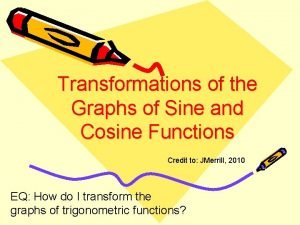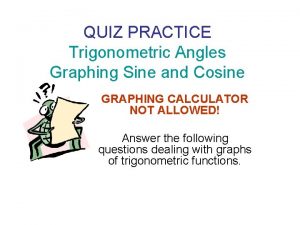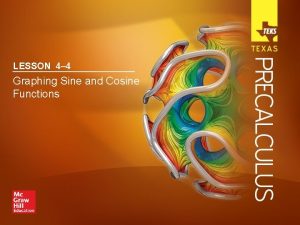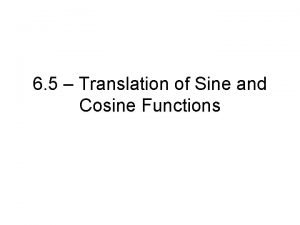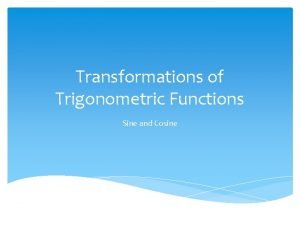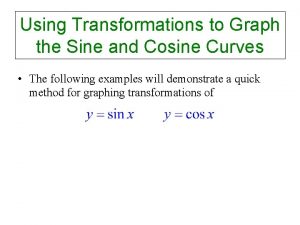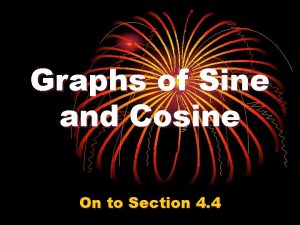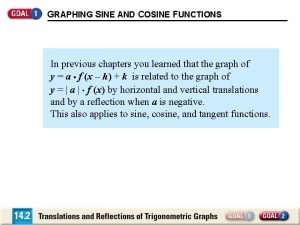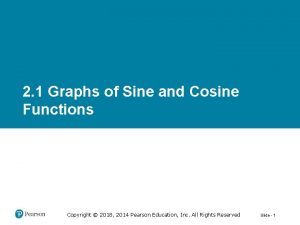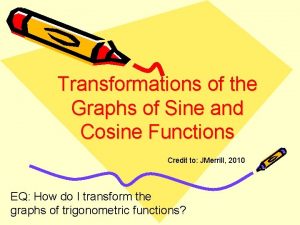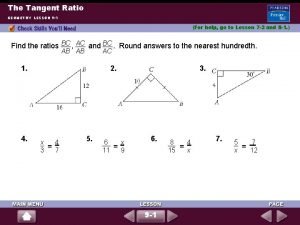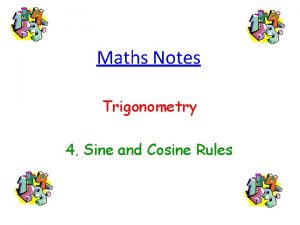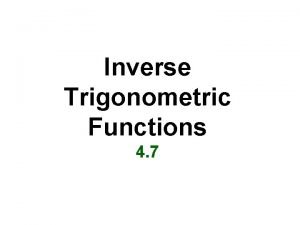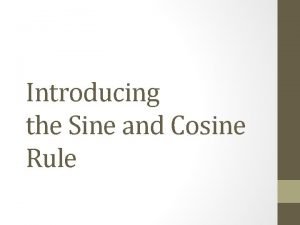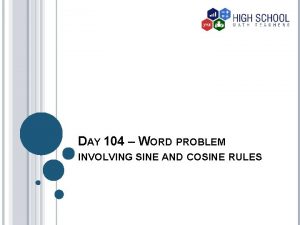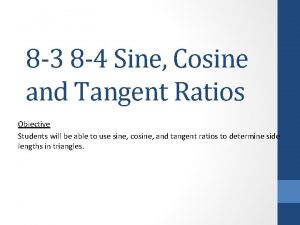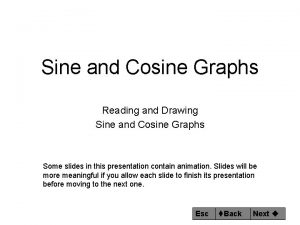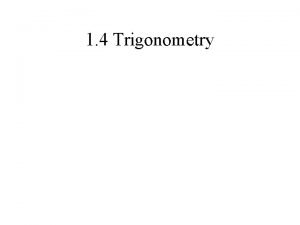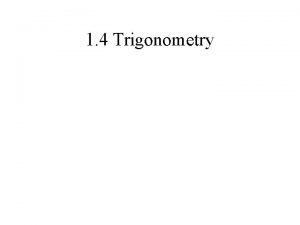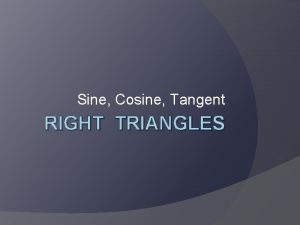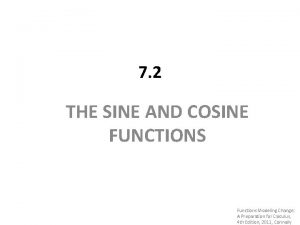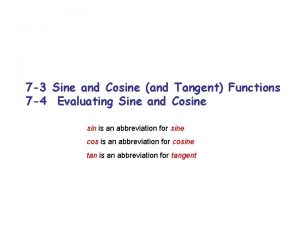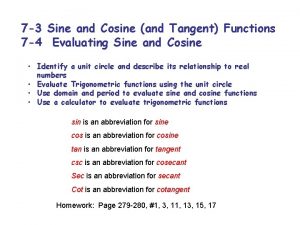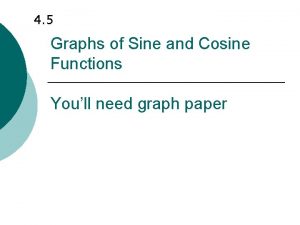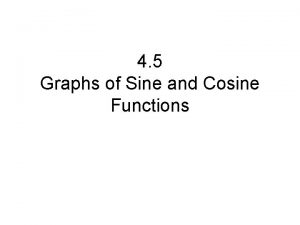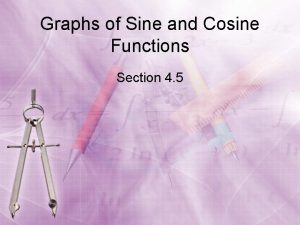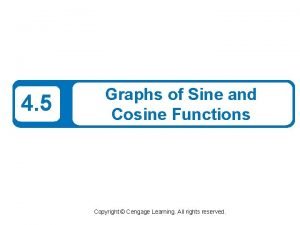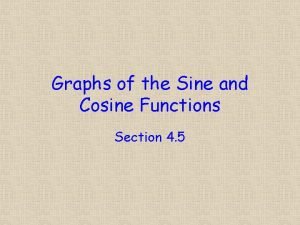6 3 THE SINE AND COSINE FUNCTIONS AND



















- Slides: 19

6. 3 THE SINE AND COSINE FUNCTIONS AND THEIR GRAPHS ♦ Define the sine and cosine functions for any angle ♦ Define the sine and cosine functions for any real number by using the unit circle and wrapping function ♦ Represent the sine and cosine functions ♦ Use the sine and cosine functions in applications ♦ Model with the sine function (optional)

TEACHING EXAMPLE 1 Suppose a robotic hand is located at the point (− 11, 60), where all units are in inches. (a) Find the length of the arm. (b) Let and represent the angle between the positive x-axis and the robotic arm. Find (c) Let and represent the angle between the positive x-axis and the robotic arm. Find How do the values for compare with the values for Copyright © 2014, 2010, 2006 Pearson Education, Inc. 2

TEACHING EXAMPLE 1 (CONTINUED) Solution (a) The length of the arm is

TEACHING EXAMPLE 1 (CONTINUED) (b) (c) Since the values of x, y, and r do not change, the trigonometric values for are the same as those for

TEACHING EXAMPLE 2 Find sin 150° and cos 150°. Support your answer using a calculator. Solution Copyright © 2014, 2010, 2006 Pearson Education, Inc. 5

TEACHING EXAMPLE 2 Verify the result with a graphing calculator in degree mode.

TEACHING EXAMPLE 3 of Find the exact values The terminal side falls in quadrant IV. Copyright © 2014, 2010, 2006 Pearson Education, Inc. 7

TEACHING EXAMPLE 4 A downhill graph is modeled by the line y = − 0. 04 x in the fourth quadrant. (a) Find the grade of the road. (b) Determine the grade resistance for a 6000 pound pickup truck. Interpret the result. Solution (a) The slope of the line is − 0. 04, so when x increases by 100 feet, y decreases by 4 feet. The grade is − 4%. Copyright © 2014, 2010, 2006 Pearson Education, Inc. 8

TEACHING EXAMPLE 4 (CONTINUED) (b) The grade resistance is given by R = W sin θ, where W = the weight of the vehicle. The point (100, − 4) lies on the terminal side of θ, so

TEACHING EXAMPLE 4 (CONTINUED) This means that gravity pulls a 6000 -pound vehicle downhill with a force of about 240 pounds.

TEACHING EXAMPLE 5 Use a calculator to approximate sin 2. 15 and cos 2. 15. Solution Copyright © 2014, 2010, 2006 Pearson Education, Inc. 11

TEACHING EXAMPLE 6 Find sin theta and cos theta if the terminal side of theta intersects the unit circle at Solution The terminal side of angle theta intersects the unit circle at the point Because this point is in the form of it follows that Copyright © 2014, 2010, 2006 Pearson Education, Inc. 12

TEACHING EXAMPLE 7 Let’s make a graph of f(t) = sin(t) for -2π ≤ t ≤ 2π. First let’s create a list of values to include. Repeat for f(t) = cos(t) over the same interval. Copyright © 2014, 2010, 2006 Pearson Education, Inc. 13 13

TEACHING EXAMPLE 8 The phases of the moon are periodic and have a period of 2π. The phases can be modeled by the function Find all phase angles θ that correspond to a full moon and all phase angles that correspond to a new moon. Assume that can be any angle measured in radians. Full Moon: peak New Moon: valley Copyright © 2014, 2010, 2006 Pearson Education, Inc. 14

TEACHING EXAMPLE 9 The amperage I in an electrical circuit after t seconds is modeled by (a) Find the range of I. (b) Evaluate and interpret the result. Solution (a) Since the range of cos t is [− 1, 1], the range of is [− 10, 10]. Copyright © 2014, 2010, 2006 Pearson Education, Inc. 15

TEACHING EXAMPLE 9 (CONTINUED) (b) This means that the amperage is 10 amps after

TEACHING EXAMPLE 10 The table lists the luminescence y of a plant after t hours, where t = 0 corresponds to midnight. (a) Graph the data and the function L(t) = 4 cos (0. 27 t) + 6. How well does the function model the data. (b) Estimate the luminescence when t = 15. (c) Use the midpoint formula to complete part (b). Are your answers the same? Why? Copyright © 2014, 2010, 2006 Pearson Education, Inc. 17

TEACHING EXAMPLE 10 (CONTINUED) Solution (a) (b)

TEACHING EXAMPLE 10 (CONTINUED) (c) Using the midpoint formula, we have The answers are not the same because the midpoint method is a linear approximation, whereas the cosine function is non-linear.
 Sine cosine transformations
Sine cosine transformations Graphing sine and cosine functions quiz
Graphing sine and cosine functions quiz 4-4 graphing sine and cosine functions worksheet answers
4-4 graphing sine and cosine functions worksheet answers Graph of sine and cosine functions
Graph of sine and cosine functions Horizontal phase shift
Horizontal phase shift Trig functions transformations
Trig functions transformations Graph of sine and cosine functions
Graph of sine and cosine functions Graph of sine and cosine functions
Graph of sine and cosine functions How to find the horizontal shift of a sine graph
How to find the horizontal shift of a sine graph Sinusoidal graphs
Sinusoidal graphs Transformations of sine and cosine functions
Transformations of sine and cosine functions Practice 9-2 sine and cosine ratios answer key
Practice 9-2 sine and cosine ratios answer key Obtuse angle sine rule
Obtuse angle sine rule Sine and cosine law maze
Sine and cosine law maze Soh cah toa rules
Soh cah toa rules What is the sine and cosine rule
What is the sine and cosine rule Sin to inverse sin
Sin to inverse sin Sine rule of triangle
Sine rule of triangle Sine and cosine law word problems
Sine and cosine law word problems Sine, cosine, and tangent
Sine, cosine, and tangent
